A Novel Expertise-Guided Machine Learning Model for Internal Fault State Diagnosis of Power Transformers
Abstract
1. Introduction
- (1)
- A novel model called the EGML model, which aims to embed expertise into AI techniques, where the BPNN model is selected as the benchmark learning model, while GA and MEA are used as optimization algorithm. Although BPNN and its improved models have been widely built to diagnose the faults of power transformers in the past, works on employing the BPNN model optimized by MEA are less likely to be found in literatures.
- (2)
- The introduction of a knowledge function to provide additional information for each individual, diversify the movement of each individual and enhance each individual’s searching and exploration capability to avoid falling into local optimum. In addition, the expertise embedded in this model will bring some corrections to the prediction results. It can provide scholars with a new perspective when diagnosing the state of power transformers.
- (3)
- Considering the difference of the data collected in reality, to further investigate the robustness of the proposed models for different sample data, four scenarios are simulated in this paper. Then, the proposed models are compared with the BPNN model and its optimization models in the diagnosis performance under four scenarios. This EGML model is not sensitive to noise data and training sample size, indicating that the model can handle the problems of noise samples and small sample size well. In addition, this model proves to be a powerful tool in the fault diagnosis of power transformers through comparative experiment among other diagnosis models. The proposed model employs the advantages of each single model and overcomes the deficits of the single model.
2. Methodology
2.1. Benchmark Learning Model: The BPNN Model
2.2. Parameter Optimization Algorithm
2.2.1. Genetic Algorithm
2.2.2. Mind Evolutionary Algorithm
2.3. Expertise-Guided Machine Learning Model
- (1)
- Guidance. Although it does not solve the problem directly, it can partially guide the data or information;
- (2)
- Application. The rule of expertise proposed in this paper can be applied to solve practical problems;
- (3)
- Promotion. The knowledge obtained in practice can be reinforced or revised in the future to make it more precise;
- (4)
- Expression. Expertise can be modular and mathematical;
- (5)
- Openness. It is able to accept information about changes in the outside world.
3. Case Study
3.1. Experimental Design
3.1.1. Data Description
3.1.2. Knowledge Representation
3.1.3. Parameter Setting and Model Performance Evaluation
3.2. Results and Discussion
3.2.1. Diagnosis Results Analysis
3.2.2. Robustness Test Analysis
3.2.3. Comparative Analysis of Different Diagnosis Models
4. Conclusions
- (a)
- The proposed EGML model is superior to the traditional BPNN model and its optimization models, such as the GA-BPNN model and the MEA-BPNN model in terms of accuracy. Thus, the proposed EGML model can be a feasible tool for fault diagnosis. The empirical results are also expected to provide scholars with a new perspective when diagnosing the fault of a power transformer.
- (b)
- Both the GA-EGML model and the MEA-EGML model are feasible for the fault diagnosis issue since they have favorable performance in accuracy and reliability. In terms of AR, the two types of EGML models are different, and the MEA-EGML model outperforms the GA-EGML model. The reason for this phenomenon is that the MEA does not have problems of local optimization and prematurity which sometimes appear in the GA.
- (c)
- Considering the difference of the data collected in reality, several sets of simulation experiments were conducted for testing the performance of the EGML model under different scenarios. Empirical results indicate the accuracy of all models in other scenarios declined compared to scenario 1, especially in scenario 2. However, the decline amplitude of each model in terms of AR was different and the proposed EGML model decreased less than the traditional model in scenario 2 and in scenario 4. Thus, the proposed model can well handle practical problems of noise data and small sample size.
- (d)
- Comparative analysis indicated that the proposed EGML model outperformed traditional models, such as IEC, SR, SVM, ELM, BPNN, and its optimization model in terms of accuracy and reliability. Specifically, the AR improvement percentages of the GA-EGML model based on other traditional diagnosis models were between 5.71% and 27.59%. Similarly, the AR improvement percentages of the MEA-EGML model were between 8.57% and 31.03%.
Author Contributions
Funding
Acknowledgments
Conflicts of Interest
References
- Sun, Y.; Dong, J. Selection of desirable transmission power mode for the bundled wind-thermal generation systems. J. Clean. Prod. 2019, 216, 585–596. [Google Scholar] [CrossRef]
- Sica, F.C.; Guimarães, F.G.; de Oliveira Duarte, R.; Reis, A.J. A cognitive system for fault prognosis in power transformers. Electr. Power Syst. Res. 2015, 127, 109–117. [Google Scholar] [CrossRef]
- Roncero-Clemente, C.; Roanes-Lozano, E. A multi-criteria computer package for power transformer fault detection and diagnosis. Appl. Math. Comput. 2018, 319, 153–164. [Google Scholar] [CrossRef]
- Peimankar, A.; Weddell, S.J.; Jalal, T.; Lapthorn, A.C. Multi-objective ensemble forecasting with an application to power transformers. Appl. Soft Comput. 2018, 68, 233–248. [Google Scholar] [CrossRef]
- Liang, Z.; Parlikad, A. A Markovian model for power transformer maintenance. Int. J. Electr. Power Energy Syst. 2018, 99, 175–182. [Google Scholar] [CrossRef]
- Jiang, J.; Wang, Z.; Ma, G.; Song, H.; Zhang, C. Direct detection of acetylene dissolved in transformer oil using spectral absorption. Optik 2019, 176, 214–220. [Google Scholar] [CrossRef]
- Fu, W.; Chen, W.; Peng, X.; Jing, S. In Study on the gas pressure characteristics of photoacoustic spectroscopy detection for dissolved gases in transformer oil. In Proceedings of the International Conference on High Voltage Engineering & Application, Shanghai, China, 17–20 September 2012. [Google Scholar]
- Liu, X.L.; Yan-Ling, M.O. Analysis and Treatment of Abnormality of Characteristic Gas Contents Caused by Bad Breath in Electric Locomotive Main Transformer. Transformer 2013, 50, 64–67. [Google Scholar]
- Liang, Y.; Kejun, L.I.; Zhao, J.; Niu, L.; Ren, J. Research on the Dynamic Monitoring Cycle Adjustment Strategy of Transformer Chromatography On-line Monitoring Devices. Proc. Csee 2014, 34, 1446–1453. [Google Scholar]
- Xiao, Q.J.; Yan, G.; Han, S.; Ke, Z. Application of the Improved Three-Ratio Method in Chromatographic Analysis of Locomotive Transformer Oil. Adv. Mater. Res. 2014, 1030–1032, 29–33. [Google Scholar]
- Xu, W.; Ruan, J.G.; Song, B. Application of Grey Correlation Analysis Method in Transformer Fault Diagnosis with Missing Code in Three-ratio Method. Bull. Sci. Technol. 2017, 33, 129–164. [Google Scholar]
- Liu, Z.X.; Song, B.; Li, E.W.; Mao, Y.; Wang, G.L. Study of “Code Absence” in the IEC Three-Ratio Method of Dissolved Gas Analysis. IEEE Electr. Insul. Mag. 2015, 31, 6–12. [Google Scholar] [CrossRef]
- Cheng, L.; Yu, T. Dissolved Gas Analysis Principle-Based Intelligent Approaches to Fault Diagnosis and Decision Making for Large Oil-Immersed Power Transformers: A Survey. Energies 2018, 11, 913. [Google Scholar] [CrossRef]
- Transformers Committee. IEEE Guide for the Interpretation of Gases Generated in Oil-Immersed Transformers; Institute of Electrical & Electronics Engineers, Inc.: New York, NY, USA, 1992. [Google Scholar]
- Saha, T.K. Review of modern diagnostic techniques for assessing insulation condition in aged transformers. IEEE Trans. Dielectr. Electr. Insul. 2003, 10, 903–917. [Google Scholar] [CrossRef]
- Jürgensen, J.H.; Nordström, L.; Hilber, P. Individual failure rates for transformers within a population based on diagnostic measures. Electr. Power Syst. Res. 2016, 141, 354–362. [Google Scholar] [CrossRef]
- Ghoneim, S.S.; Taha, I.B. A new approach of DGA interpretation technique for transformer fault diagnosis. Int. J. Electr. Power Energy Syst. 2016, 81, 265–274. [Google Scholar] [CrossRef]
- Yadaiah, N.; Ravi, N. Internal fault detection techniques for power transformers. Appl. Soft Comput. 2011, 11, 5259–5269. [Google Scholar] [CrossRef]
- Peimankar, A.; Weddell, S.J.; Jalal, T.; Lapthorn, A.C. Evolutionary multi-objective fault diagnosis of power transformers. Swarm Evol. Comput. 2017, 36, 62–75. [Google Scholar] [CrossRef]
- Ma, D.; Zhang, W.; Wei, Y. Establish Expert System of Transformer Fault Diagnosis Based on Dissolved Gas in Oil. In Proceedings of the International Conference on Information Science & Cloud Computing Companion, Guangzhou, China, 7–8 December 2014. [Google Scholar]
- Mani, G.; Jerome, J. Intuitionistic fuzzy expert system based fault diagnosis using dissolved gas analysis for power transformer. J. Electr. Eng. Technol. 2014, 9, 2058–2064. [Google Scholar] [CrossRef]
- Huang, Y.C.; Sun, H.C. Dissolved gas analysis of mineral oil for power transformer fault diagnosis using fuzzy logic. IEEE Trans. Dielectr. Electr. Insul. 2013, 20, 974–981. [Google Scholar] [CrossRef]
- Velásquez, R.M.A.; Lara, J.V.M. Principal Components Analysis and Adaptive Decision System Based on Fuzzy Logic for Power Transformer. Fuzzy Inf. Eng. 2017, 9, 493–514. [Google Scholar] [CrossRef]
- Bacha, K.; Souahlia, S.; Gossa, M. Power transformer fault diagnosis based on dissolved gas analysis by support vector machine. Electr. Power Syst. Res. 2012, 83, 73–79. [Google Scholar] [CrossRef]
- Fei, S.W.; Zhang, X.B. Fault diagnosis of power transformer based on support vector machine with genetic algorithm. Expert Syst. Appl. 2009, 36, 11352–11357. [Google Scholar] [CrossRef]
- Malik, H.; Mishra, S. Extreme learning machine based fault diagnosis of power transformer using IEC TC10 and its related data. In Proceedings of the 2015 Annual IEEE India Conference (INDICON), New Delhi, India, 17–20 December 2016. [Google Scholar]
- Yuan, H.; Guangning, W.U.; Gao, B. Fault Diagnosis of Power Transformer Using Particle Swarm Optimization and Extreme Learning Machine Based on DGA. High Volt. Appar. 2016, 52, 176–180. [Google Scholar]
- Žarković, M.; Stojković, Z. Analysis of artificial intelligence expert systems for power transformer condition monitoring and diagnostics. Electr. Power Syst. Res. 2017, 149, 125–136. [Google Scholar] [CrossRef]
- Zhang, Y.; Ling, W.U. Transformer Fault Diagnosis Based on C-SVC and Cross-validation Algorithm. Electr. Power 2012, 11, 52–55. [Google Scholar]
- Yin, Y.; Wang, M.; Zhang, J.; Yuan, P.; Zhan, J.; Guo, C. An Autonomic Kernel Optimization Method to Diagnose Transformer Faults by Multi-Kernel Learning Support Vector Classifier Based on Binary Particle Swarm Optimization. Power Syst. Technol. 2012, 36, 249–254. [Google Scholar]
- Rigatos, G.; Siano, P. Power transformers’ condition monitoring using neural modeling and the local statistical approach to fault diagnosis. Int. J. Electr. Power Energy Syst. 2016, 80, 150–159. [Google Scholar] [CrossRef]
- Souahlia, S.; Bacha, K.; Chaari, A. MLP neural network-based decision for power transformers fault diagnosis using an improved combination of Rogers and Doernenburg ratios DGA. Int. J. Electr. Power Energy Syst. 2012, 43, 1346–1353. [Google Scholar] [CrossRef]
- Yang, H.C.; Chen, W.; Li, A.Y.; Yang, C.S.; Xie, Z.H.; Dong, H.Y. BA-PNN-based methods for power transformer fault diagnosis. Adv. Eng. Inform. 2019, 39, 178–185. [Google Scholar] [CrossRef]
- Ma, D.; Liang, Y.; Zhao, X.; Guan, R.; Shi, X. Multi-BP expert system for fault diagnosis of powersystem. Eng. Appl. Artif. Intell. 2013, 26, 937–944. [Google Scholar] [CrossRef]
- Balaga, H.; Gupta, N.; Vishwakarma, D.N. GA trained parallel hidden layered ANN based differential protection of three phase power transformer. Int. J. Electr. Power Energy Syst. 2015, 67, 286–297. [Google Scholar] [CrossRef]
- Shao, M.; Zhu, X.J.; Cao, H.F.; Shen, H.F. An artificial neural network ensemble method for fault diagnosis ofproton exchange membrane fuel cell system. Energy 2014, 67, 268–275. [Google Scholar] [CrossRef]
- Yang, Z.; Peng, L.; Wang, Z.; Lei, Z.; Hong, J. Fault and defect diagnosis of battery for electric vehicles based on big data analysis methods. Appl. Energy 2017, 207, 354–362. [Google Scholar] [CrossRef]
- Chine, W.; Mellit, A.; Lughi, V.; Malek, A.; Sulligoi, G.; Pavan, A.M. A novel fault diagnosis technique for photovoltaic systems based on artificial neural networks. Renew. Energy 2016, 90, 501–512. [Google Scholar] [CrossRef]
- Du, Z.; Bo, F.; Jin, X.; Chi, J. Fault detection and diagnosis for buildings and HVAC systems using combined neural networks and subtractive clustering analysis. Build. Environ. 2014, 73, 1–11. [Google Scholar] [CrossRef]
- Zhu, Z.; Peng, G.; Chen, Y.; Gao, H. A convolutional neural network based on a capsule network with strong generalization for bearing fault diagnosis. Neurocomputing 2019, 323, 62–75. [Google Scholar] [CrossRef]
- Guo, Y.; Tan, Z.; Chen, H.; Li, G.; Wang, J.; Huang, R.; Liu, J.; Ahmad, T. Deep learning-based fault diagnosis of variable refrigerant flow air-conditioning system for building energy saving. Appl. Energy 2018, 225, 732–745. [Google Scholar] [CrossRef]
- Liu, H.; Zhou, J.; Xu, Y.; Zheng, Y.; Peng, X.; Jiang, W. Unsupervised fault diagnosis of rolling bearings using a deep neural network based on generative adversarial networks. Neurocomputing 2018, 315, 412–424. [Google Scholar] [CrossRef]
- Shi, S.; Li, G.; Chen, H.; Hu, Y.; Wang, X.; Guo, Y.; Sun, S. An efficient VRF system fault diagnosis strategy for refrigerant charge amount based on PCA and dual neural network model. Appl. Therm. Eng. 2018, 129, 1252–1262. [Google Scholar] [CrossRef]
- Wang, S.; Zhang, N.; Wu, L.; Wang, Y. Wind speed forecasting based on the hybrid ensemble empirical mode decomposition and GA-BP neural network method. Renew. Energy 2016, 94, 629–636. [Google Scholar] [CrossRef]
- Feng, Y.U.; Xiaozhong, X.U. A short-term load forecasting model of natural gas based on optimized genetic algorithm and improved BP neural network. Appl. Energy 2014, 134, 102–113. [Google Scholar]
- Wang, W.; Tang, R.; Cheng, L.; Liu, P.; Liang, L. A BP neural network model optimized by Mind Evolutionary Algorithm for predicting the ocean wave heights. Ocean Eng. 2018, 162, 98–107. [Google Scholar] [CrossRef]
- You, L.; Tan, Q.; Kang, Y.; Xu, C.; Chong, L. Reconstruction and prediction of capillary pressure curve based on Particle Swarm Optimization-Back Propagation Neural Network method. Petroleum 2018, 4, 268–280. [Google Scholar] [CrossRef]
- Wang, H.S.; Wang, Y.N.; Wang, Y.C. Cost estimation of plastic injection molding parts through integration of PSO and BP neural network. Expert Syst. Appl. 2013, 40, 418–428. [Google Scholar] [CrossRef]
- Li, Z.; Jing, Z.; Pei, D.; Zhao, Y.; Bo, P. An SA–GA–BP neural network-based color correction algorithm for TCM tongue images. Neurocomputing 2014, 134, 111–116. [Google Scholar]
- Bento, P.; Pombo, J.; Calado, M.; Mariano, S. A bat optimized neural network and wavelet transform approach for short-term price forecasting. Appl. Energy 2018, 210, 88–97. [Google Scholar] [CrossRef]
- Şenyiğit, E.; Düğenci, M.; Aydin, M.E.; Zeydan, M. Heuristic-based neural networks for stochastic dynamic lot sizing problem. Appl. Soft Comput. 2013, 13, 1332–1339. [Google Scholar] [CrossRef]
- Sun, C.; Yan, S.; Yu, S. In Model-selection-based economic prediction system using MEBML. In Proceedings of the IEEE International Conference on Systems, Man, and Cybernetics (Cat. No.99CH37028), Tokyo, Japan, 12–15 October 1999. [Google Scholar]
- Yao, H. Power Transformer Fault Diagnosis Based on Improved Artificial Fish Algorithm-Rbf Network; Guangxi University: Nanning, China, 2016. [Google Scholar]
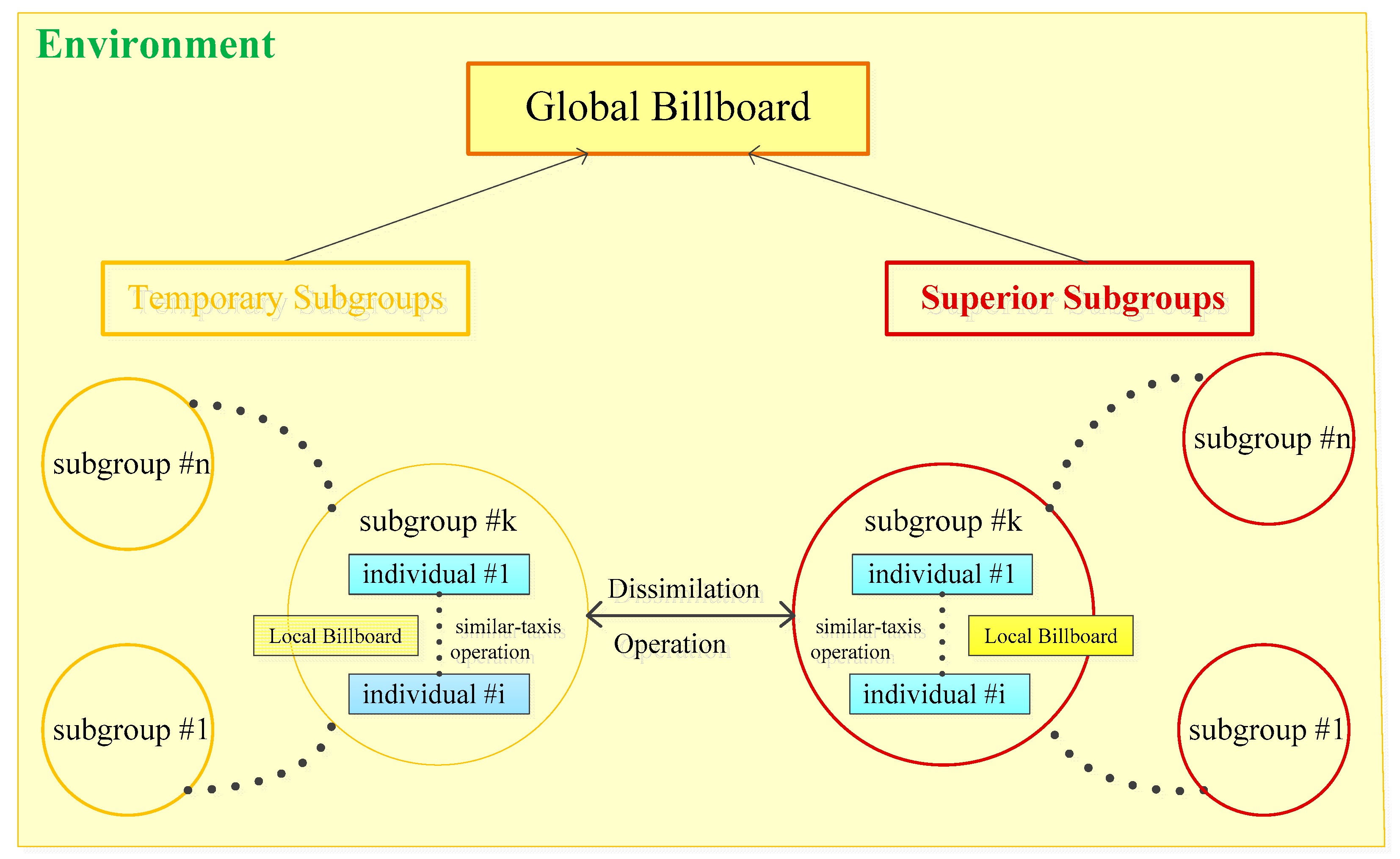
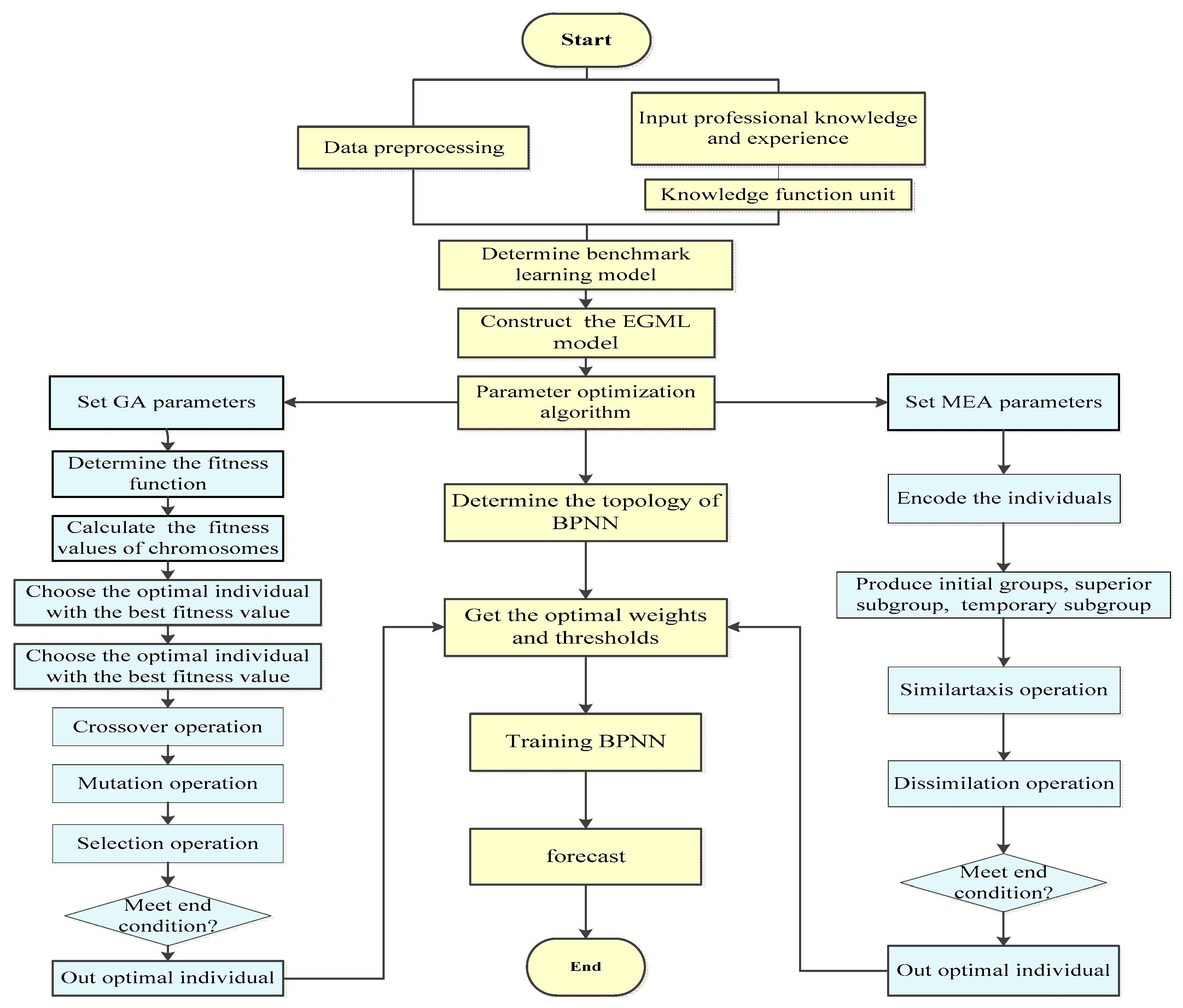
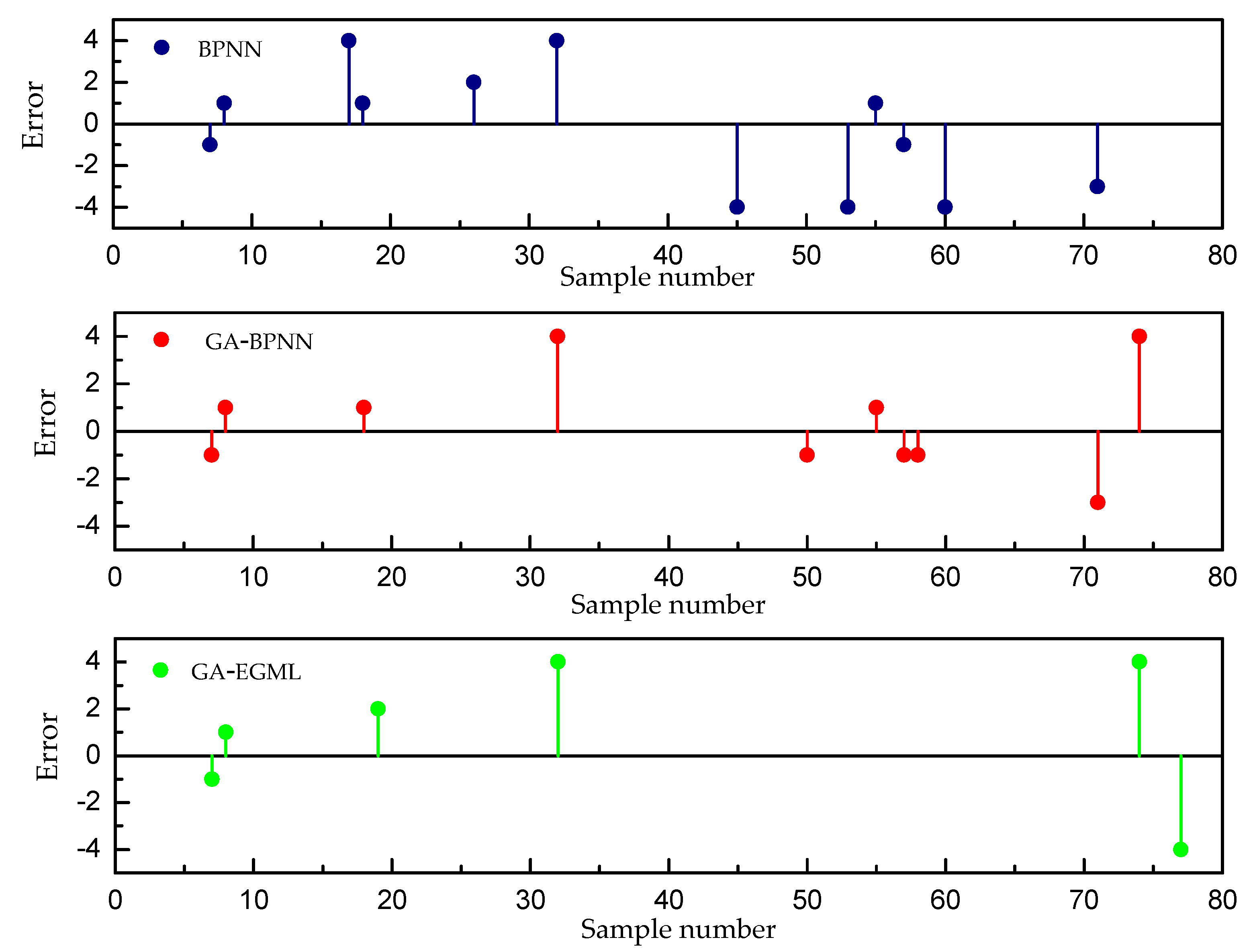
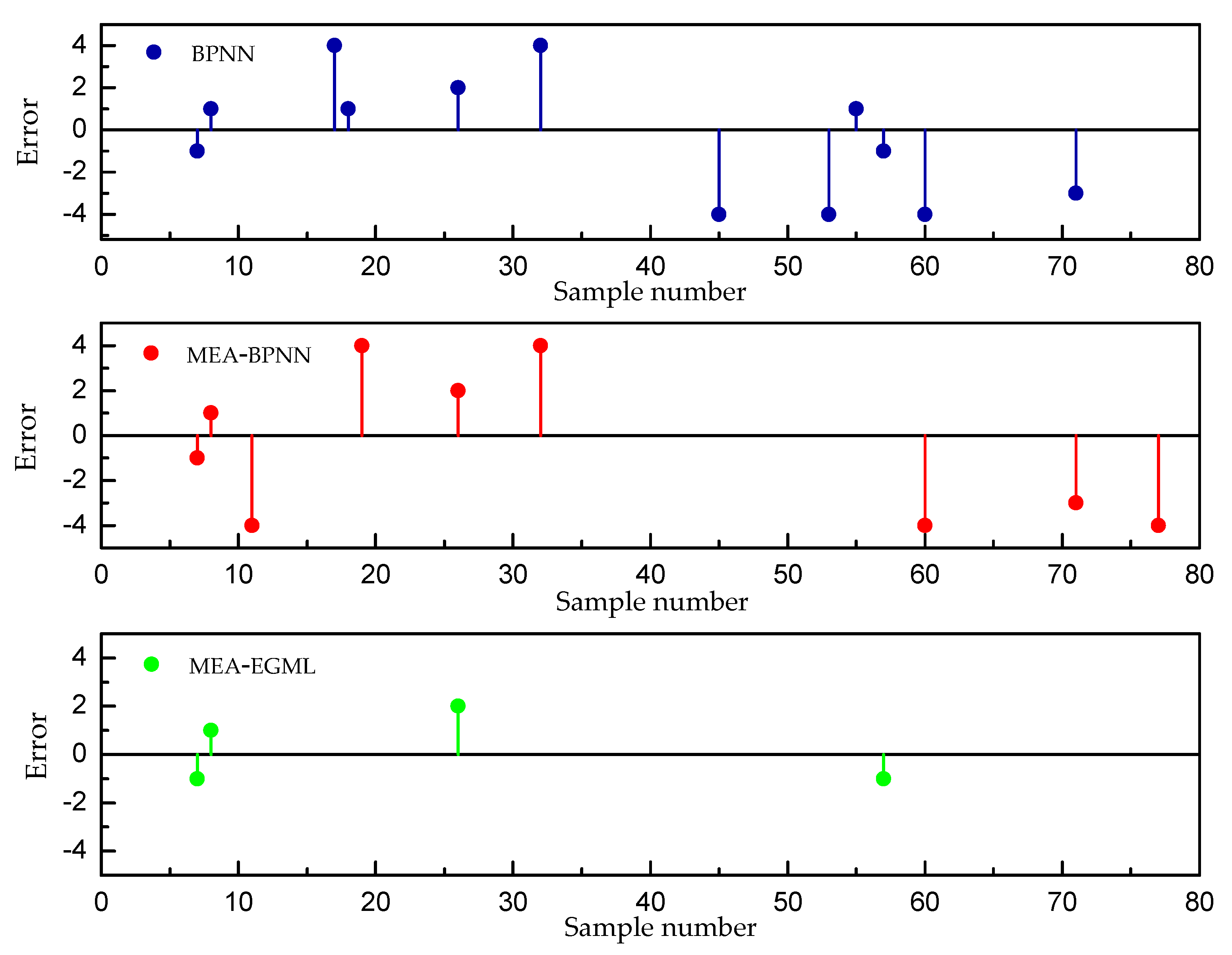
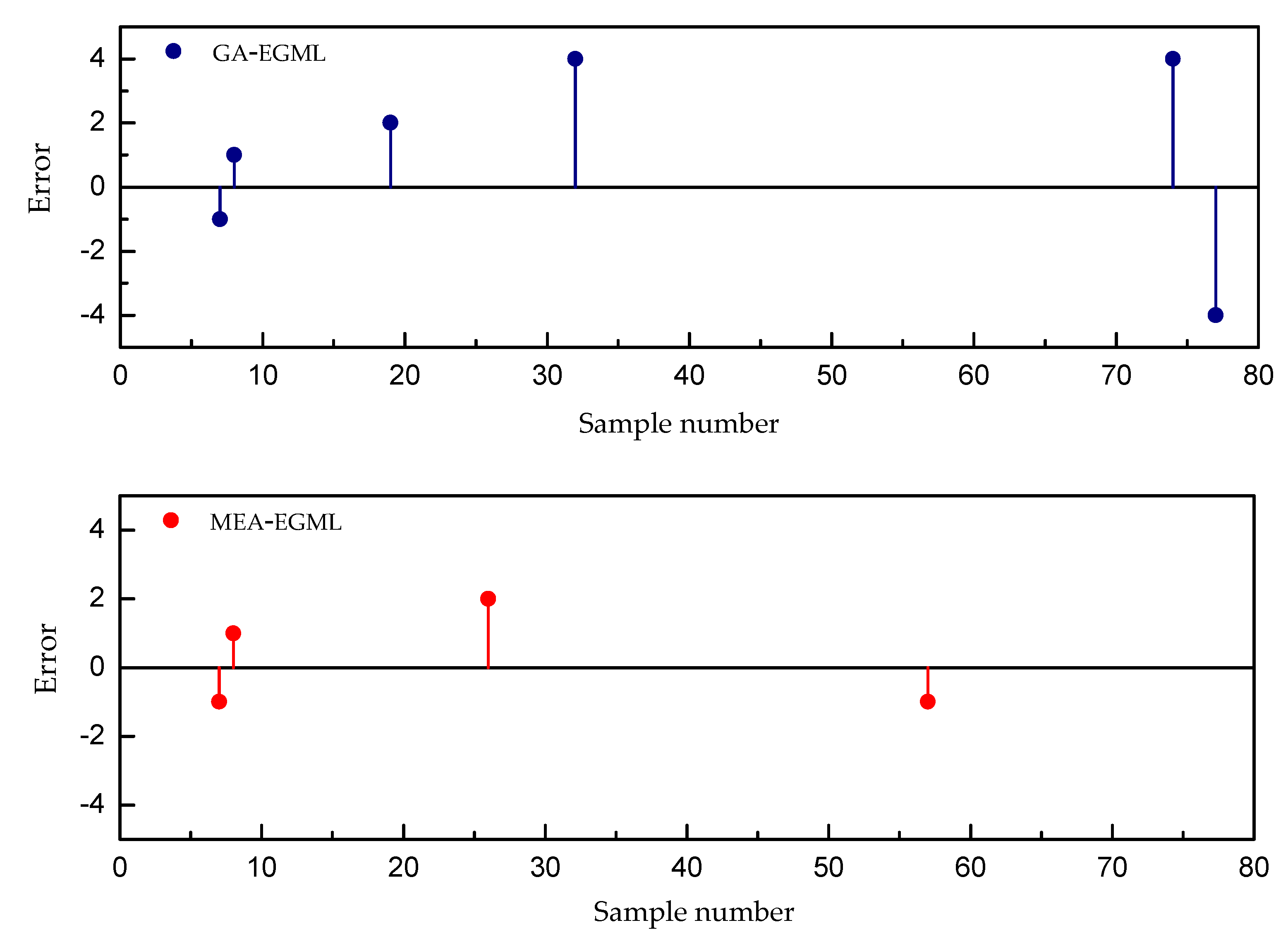

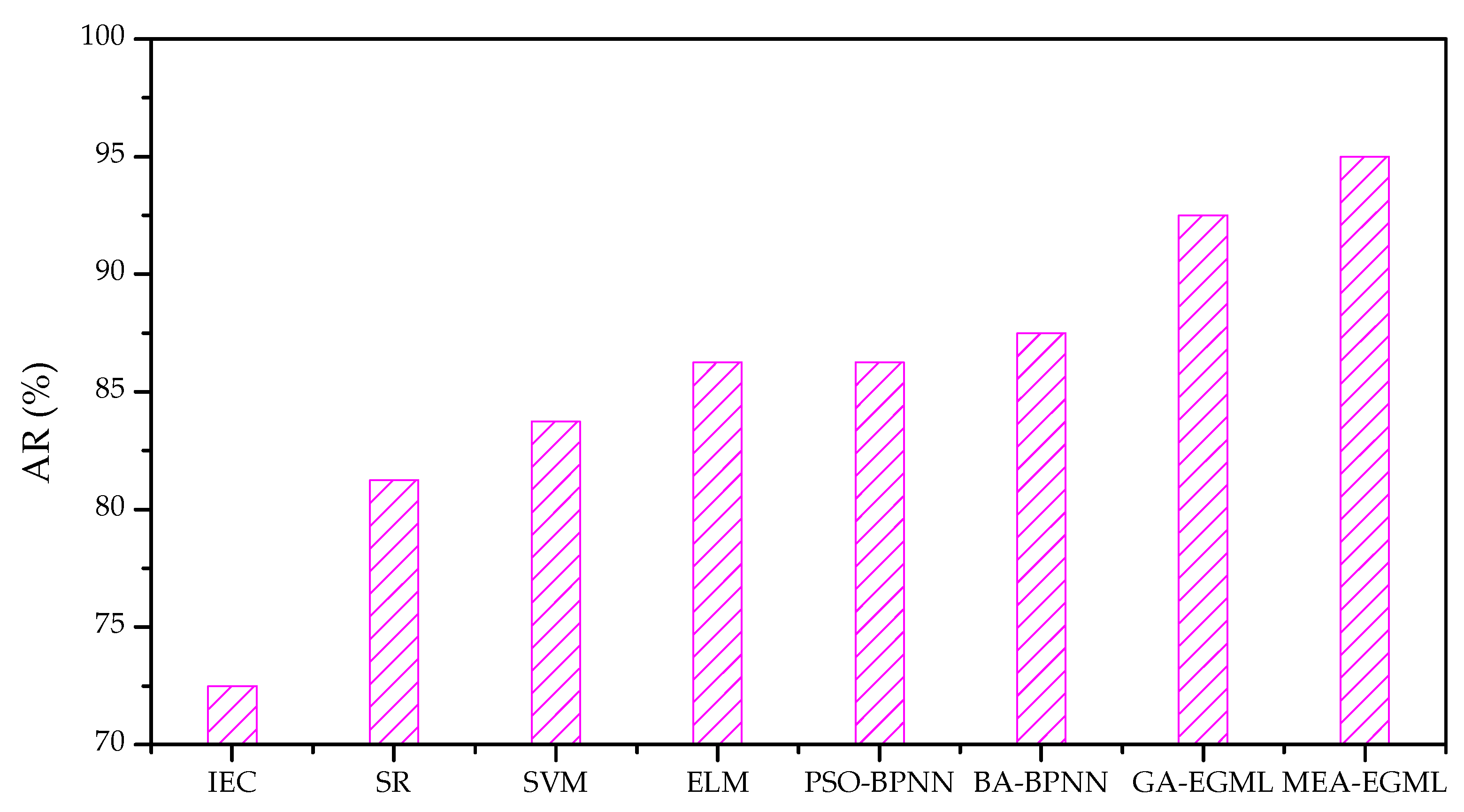
| Fault Type | Abbreviation | Sample |
|---|---|---|
| High thermal fault | HT | 75 |
| Medium thermal fault | MT | 49 |
| Low thermal fault | LT | 17 |
| Partial discharge | PD | 20 |
| High energy discharge | HD | 75 |
| Low energy discharge | LD | 74 |
| Parameter | Value | Parameters | Values |
|---|---|---|---|
| Performance function | Probability of mutation | 0.01 | |
| The number of iterations | 1000 | Size of population | 500 |
| Learning rate | 0.1 | Number of superior groups | 5 |
| Size of chromosomes | 200 | Number of temporary groups | 5 |
| Probability of crossover | 0.25 | Number of hidden layer neurons | 10 |
| Indexes | BPNN | GA-BPNN | GA-EGML | MEA-BPNN | MEA-EGML |
|---|---|---|---|---|---|
| (%) | 85.00 | 87.50 | 92.5 | 88.75 | 95.00 |
© 2019 by the authors. Licensee MDPI, Basel, Switzerland. This article is an open access article distributed under the terms and conditions of the Creative Commons Attribution (CC BY) license (http://creativecommons.org/licenses/by/4.0/).
Share and Cite
Wu, Q.; Zhang, H. A Novel Expertise-Guided Machine Learning Model for Internal Fault State Diagnosis of Power Transformers. Sustainability 2019, 11, 1562. https://doi.org/10.3390/su11061562
Wu Q, Zhang H. A Novel Expertise-Guided Machine Learning Model for Internal Fault State Diagnosis of Power Transformers. Sustainability. 2019; 11(6):1562. https://doi.org/10.3390/su11061562
Chicago/Turabian StyleWu, Qunli, and Hongjie Zhang. 2019. "A Novel Expertise-Guided Machine Learning Model for Internal Fault State Diagnosis of Power Transformers" Sustainability 11, no. 6: 1562. https://doi.org/10.3390/su11061562
APA StyleWu, Q., & Zhang, H. (2019). A Novel Expertise-Guided Machine Learning Model for Internal Fault State Diagnosis of Power Transformers. Sustainability, 11(6), 1562. https://doi.org/10.3390/su11061562





